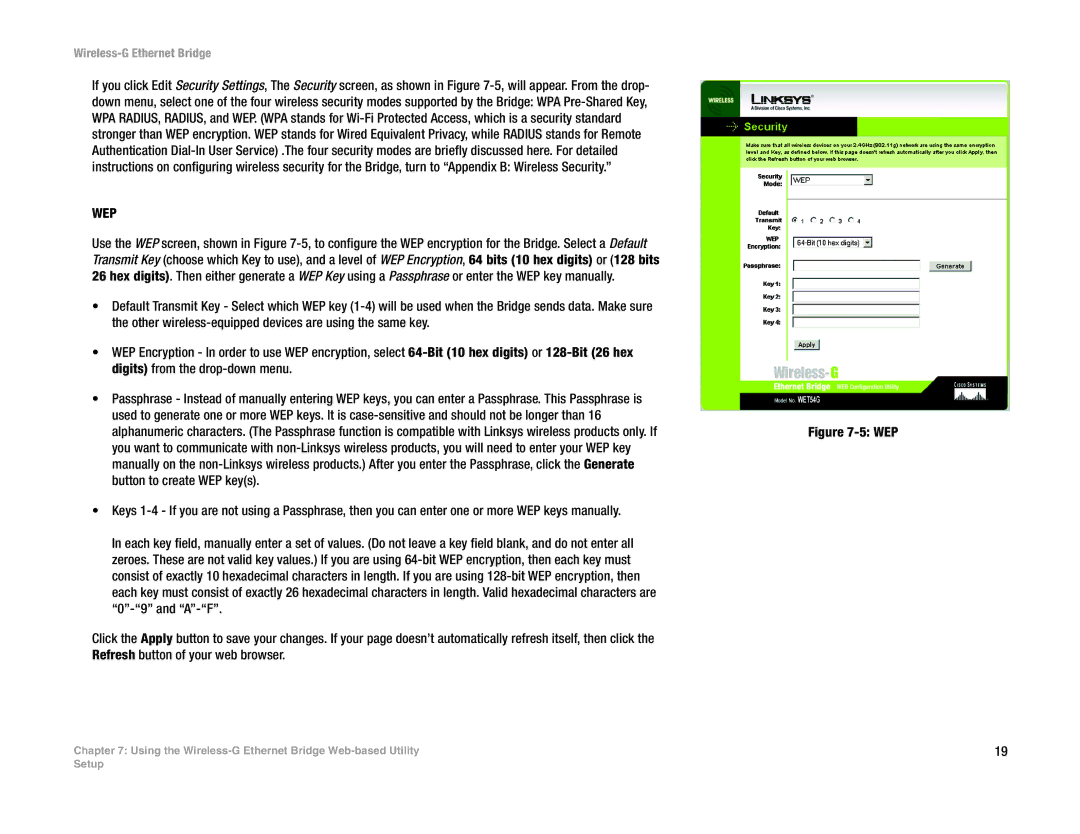Wireless-G Ethernet Bridge
If you click Edit Security Settings, The Security screen, as shown in Figure 7-5, will appear. From the drop- down menu, select one of the four wireless security modes supported by the Bridge: WPA Pre-Shared Key, WPA RADIUS, RADIUS, and WEP. (WPA stands for Wi-Fi Protected Access, which is a security standard stronger than WEP encryption. WEP stands for Wired Equivalent Privacy, while RADIUS stands for Remote Authentication Dial-In User Service) .The four security modes are briefly discussed here. For detailed instructions on configuring wireless security for the Bridge, turn to “Appendix B: Wireless Security.”
WEP
Use the WEP screen, shown in Figure 7-5, to configure the WEP encryption for the Bridge. Select a Default Transmit Key (choose which Key to use), and a level of WEP Encryption, 64 bits (10 hex digits) or (128 bits 26 hex digits). Then either generate a WEP Key using a Passphrase or enter the WEP key manually.
•Default Transmit Key - Select which WEP key (1-4) will be used when the Bridge sends data. Make sure the other wireless-equipped devices are using the same key.
•WEP Encryption - In order to use WEP encryption, select 64-Bit (10 hex digits) or 128-Bit (26 hex digits) from the drop-down menu.
•Passphrase - Instead of manually entering WEP keys, you can enter a Passphrase. This Passphrase is used to generate one or more WEP keys. It is case-sensitive and should not be longer than 16 alphanumeric characters. (The Passphrase function is compatible with Linksys wireless products only. If you want to communicate with non-Linksys wireless products, you will need to enter your WEP key manually on the non-Linksys wireless products.) After you enter the Passphrase, click the Generate button to create WEP key(s).
•Keys 1-4 - If you are not using a Passphrase, then you can enter one or more WEP keys manually.
In each key field, manually enter a set of values. (Do not leave a key field blank, and do not enter all zeroes. These are not valid key values.) If you are using 64-bit WEP encryption, then each key must consist of exactly 10 hexadecimal characters in length. If you are using 128-bit WEP encryption, then each key must consist of exactly 26 hexadecimal characters in length. Valid hexadecimal characters are “0”-“9” and “A”-“F”.
Click the Apply button to save your changes. If your page doesn’t automatically refresh itself, then click the Refresh button of your web browser.
Chapter 7: Using the Wireless-G Ethernet Bridge Web-based Utility

